Insolvent Trading and Consequences: A Case Study of York Civil Construction Company
VerifiedAdded on 2023/06/03
|5
|985
|360
AI Summary
This article discusses the case of York Civil Construction Company and the consequences of insolvent trading. It analyzes the lack of cash resources and the company's decision to continue trading while insolvent. The article also highlights the penalties that the company and its directors may face due to insolvent trading.
Contribute Materials
Your contribution can guide someone’s learning journey. Share your
documents today.
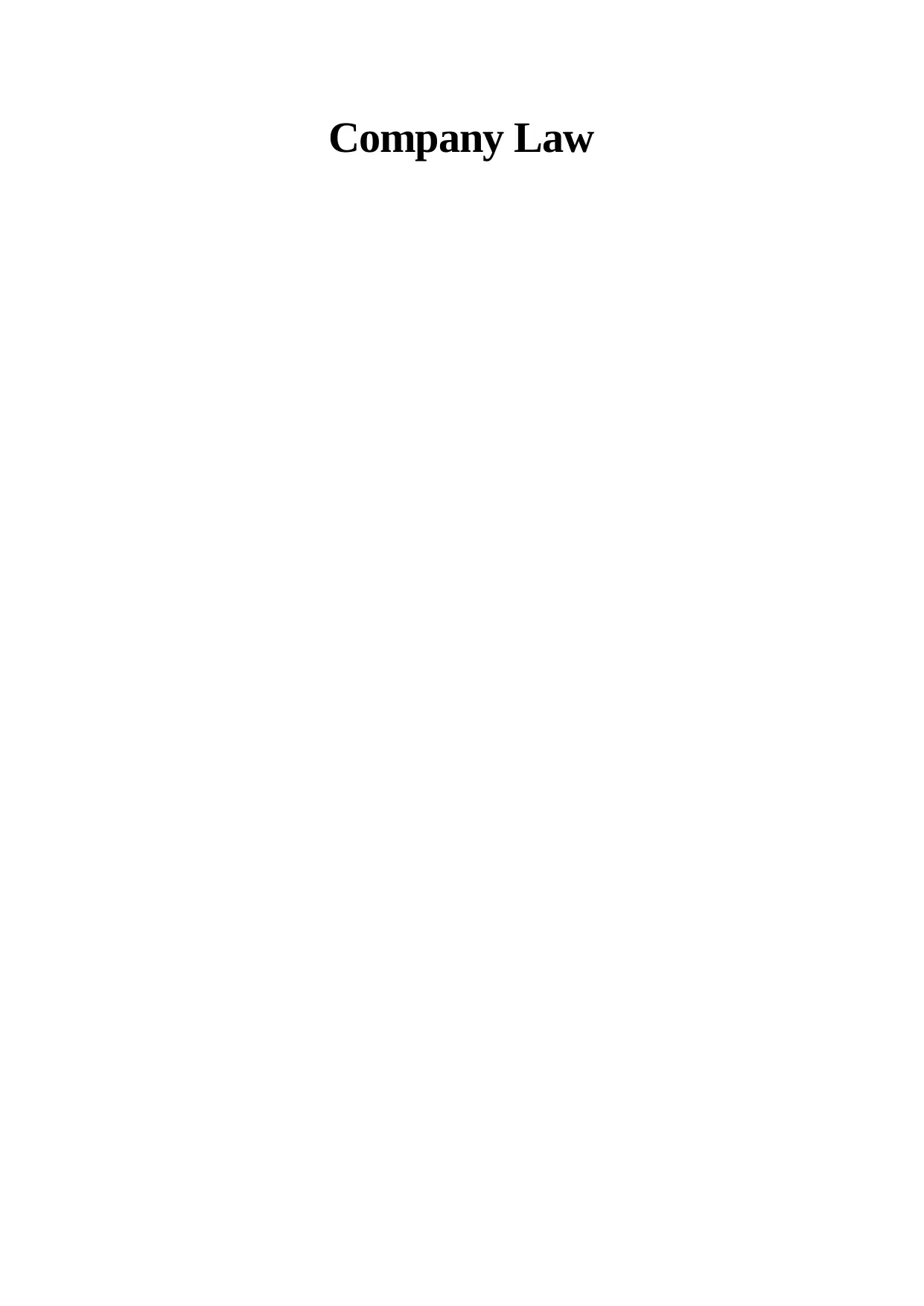
Company Law
Secure Best Marks with AI Grader
Need help grading? Try our AI Grader for instant feedback on your assignments.
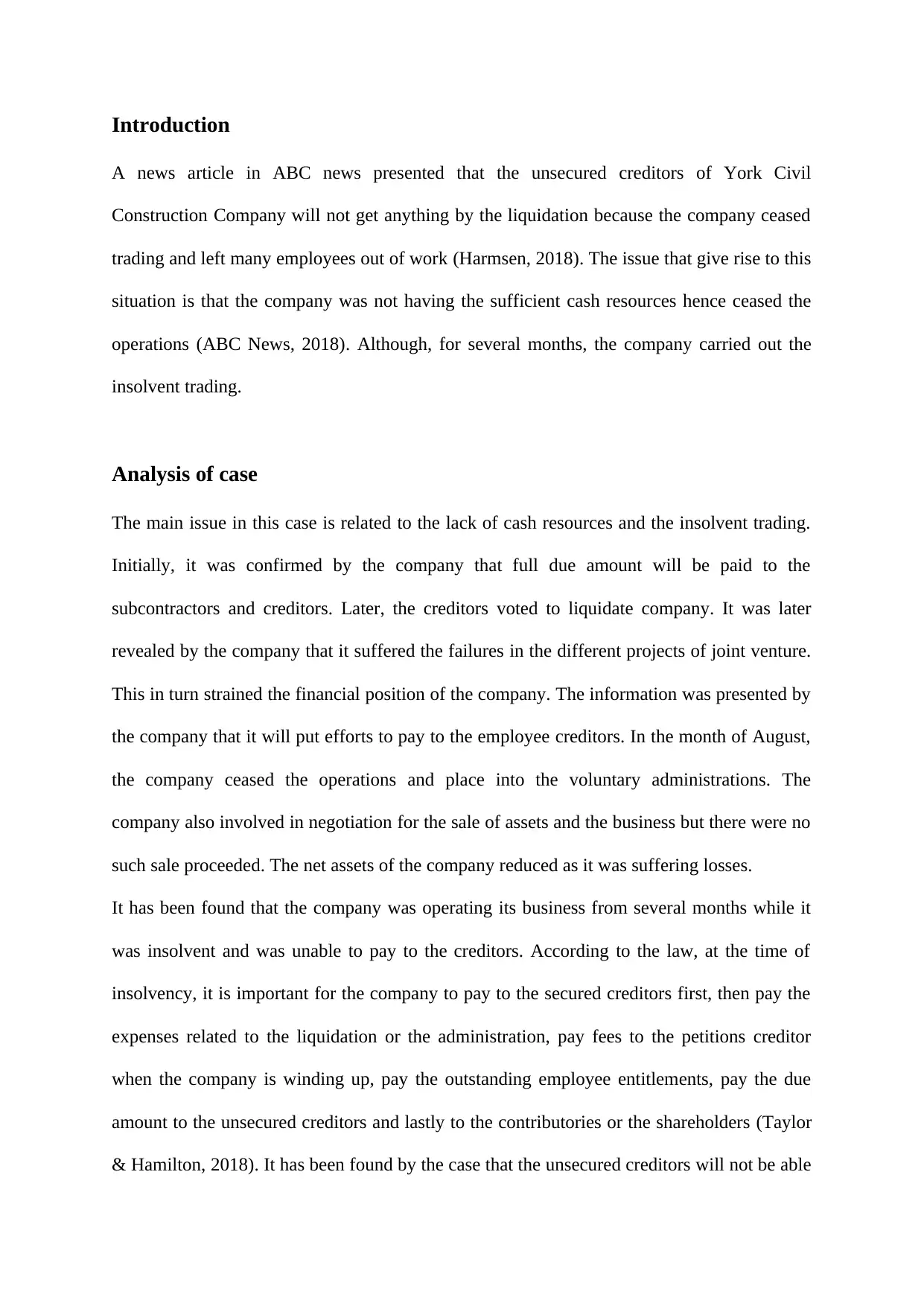
Introduction
A news article in ABC news presented that the unsecured creditors of York Civil
Construction Company will not get anything by the liquidation because the company ceased
trading and left many employees out of work (Harmsen, 2018). The issue that give rise to this
situation is that the company was not having the sufficient cash resources hence ceased the
operations (ABC News, 2018). Although, for several months, the company carried out the
insolvent trading.
Analysis of case
The main issue in this case is related to the lack of cash resources and the insolvent trading.
Initially, it was confirmed by the company that full due amount will be paid to the
subcontractors and creditors. Later, the creditors voted to liquidate company. It was later
revealed by the company that it suffered the failures in the different projects of joint venture.
This in turn strained the financial position of the company. The information was presented by
the company that it will put efforts to pay to the employee creditors. In the month of August,
the company ceased the operations and place into the voluntary administrations. The
company also involved in negotiation for the sale of assets and the business but there were no
such sale proceeded. The net assets of the company reduced as it was suffering losses.
It has been found that the company was operating its business from several months while it
was insolvent and was unable to pay to the creditors. According to the law, at the time of
insolvency, it is important for the company to pay to the secured creditors first, then pay the
expenses related to the liquidation or the administration, pay fees to the petitions creditor
when the company is winding up, pay the outstanding employee entitlements, pay the due
amount to the unsecured creditors and lastly to the contributories or the shareholders (Taylor
& Hamilton, 2018). It has been found by the case that the unsecured creditors will not be able
A news article in ABC news presented that the unsecured creditors of York Civil
Construction Company will not get anything by the liquidation because the company ceased
trading and left many employees out of work (Harmsen, 2018). The issue that give rise to this
situation is that the company was not having the sufficient cash resources hence ceased the
operations (ABC News, 2018). Although, for several months, the company carried out the
insolvent trading.
Analysis of case
The main issue in this case is related to the lack of cash resources and the insolvent trading.
Initially, it was confirmed by the company that full due amount will be paid to the
subcontractors and creditors. Later, the creditors voted to liquidate company. It was later
revealed by the company that it suffered the failures in the different projects of joint venture.
This in turn strained the financial position of the company. The information was presented by
the company that it will put efforts to pay to the employee creditors. In the month of August,
the company ceased the operations and place into the voluntary administrations. The
company also involved in negotiation for the sale of assets and the business but there were no
such sale proceeded. The net assets of the company reduced as it was suffering losses.
It has been found that the company was operating its business from several months while it
was insolvent and was unable to pay to the creditors. According to the law, at the time of
insolvency, it is important for the company to pay to the secured creditors first, then pay the
expenses related to the liquidation or the administration, pay fees to the petitions creditor
when the company is winding up, pay the outstanding employee entitlements, pay the due
amount to the unsecured creditors and lastly to the contributories or the shareholders (Taylor
& Hamilton, 2018). It has been found by the case that the unsecured creditors will not be able
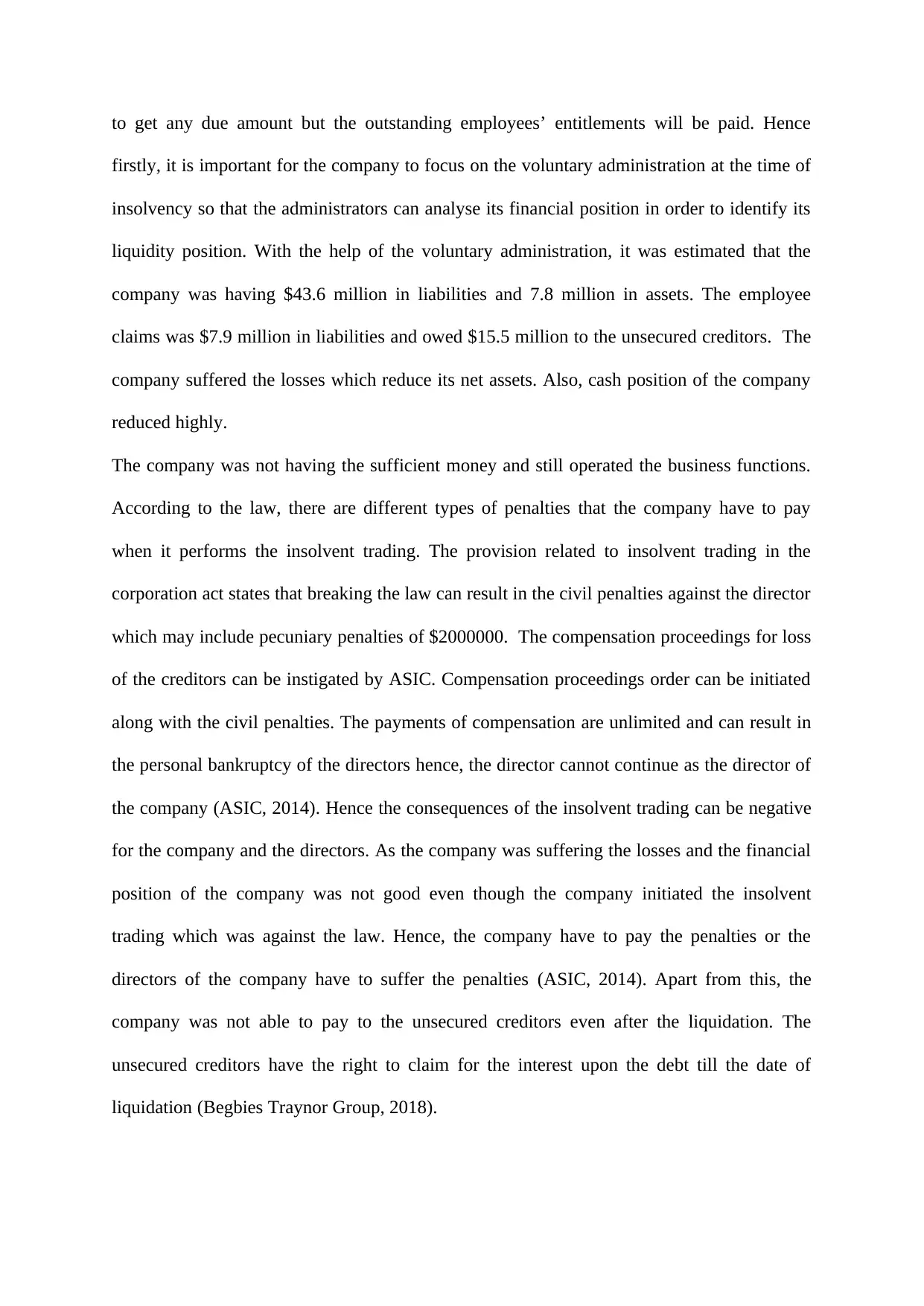
to get any due amount but the outstanding employees’ entitlements will be paid. Hence
firstly, it is important for the company to focus on the voluntary administration at the time of
insolvency so that the administrators can analyse its financial position in order to identify its
liquidity position. With the help of the voluntary administration, it was estimated that the
company was having $43.6 million in liabilities and 7.8 million in assets. The employee
claims was $7.9 million in liabilities and owed $15.5 million to the unsecured creditors. The
company suffered the losses which reduce its net assets. Also, cash position of the company
reduced highly.
The company was not having the sufficient money and still operated the business functions.
According to the law, there are different types of penalties that the company have to pay
when it performs the insolvent trading. The provision related to insolvent trading in the
corporation act states that breaking the law can result in the civil penalties against the director
which may include pecuniary penalties of $2000000. The compensation proceedings for loss
of the creditors can be instigated by ASIC. Compensation proceedings order can be initiated
along with the civil penalties. The payments of compensation are unlimited and can result in
the personal bankruptcy of the directors hence, the director cannot continue as the director of
the company (ASIC, 2014). Hence the consequences of the insolvent trading can be negative
for the company and the directors. As the company was suffering the losses and the financial
position of the company was not good even though the company initiated the insolvent
trading which was against the law. Hence, the company have to pay the penalties or the
directors of the company have to suffer the penalties (ASIC, 2014). Apart from this, the
company was not able to pay to the unsecured creditors even after the liquidation. The
unsecured creditors have the right to claim for the interest upon the debt till the date of
liquidation (Begbies Traynor Group, 2018).
firstly, it is important for the company to focus on the voluntary administration at the time of
insolvency so that the administrators can analyse its financial position in order to identify its
liquidity position. With the help of the voluntary administration, it was estimated that the
company was having $43.6 million in liabilities and 7.8 million in assets. The employee
claims was $7.9 million in liabilities and owed $15.5 million to the unsecured creditors. The
company suffered the losses which reduce its net assets. Also, cash position of the company
reduced highly.
The company was not having the sufficient money and still operated the business functions.
According to the law, there are different types of penalties that the company have to pay
when it performs the insolvent trading. The provision related to insolvent trading in the
corporation act states that breaking the law can result in the civil penalties against the director
which may include pecuniary penalties of $2000000. The compensation proceedings for loss
of the creditors can be instigated by ASIC. Compensation proceedings order can be initiated
along with the civil penalties. The payments of compensation are unlimited and can result in
the personal bankruptcy of the directors hence, the director cannot continue as the director of
the company (ASIC, 2014). Hence the consequences of the insolvent trading can be negative
for the company and the directors. As the company was suffering the losses and the financial
position of the company was not good even though the company initiated the insolvent
trading which was against the law. Hence, the company have to pay the penalties or the
directors of the company have to suffer the penalties (ASIC, 2014). Apart from this, the
company was not able to pay to the unsecured creditors even after the liquidation. The
unsecured creditors have the right to claim for the interest upon the debt till the date of
liquidation (Begbies Traynor Group, 2018).
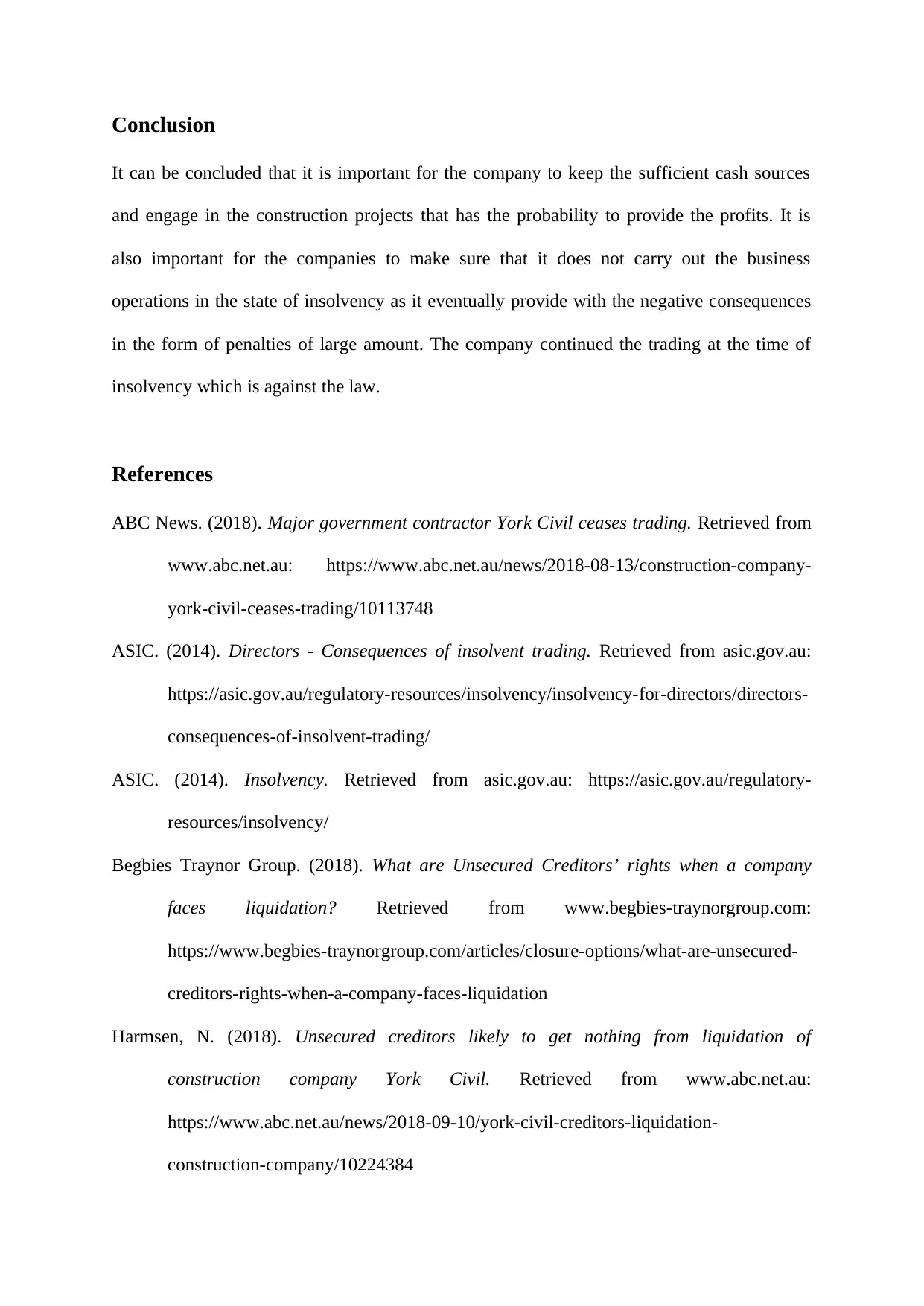
Conclusion
It can be concluded that it is important for the company to keep the sufficient cash sources
and engage in the construction projects that has the probability to provide the profits. It is
also important for the companies to make sure that it does not carry out the business
operations in the state of insolvency as it eventually provide with the negative consequences
in the form of penalties of large amount. The company continued the trading at the time of
insolvency which is against the law.
References
ABC News. (2018). Major government contractor York Civil ceases trading. Retrieved from
www.abc.net.au: https://www.abc.net.au/news/2018-08-13/construction-company-
york-civil-ceases-trading/10113748
ASIC. (2014). Directors - Consequences of insolvent trading. Retrieved from asic.gov.au:
https://asic.gov.au/regulatory-resources/insolvency/insolvency-for-directors/directors-
consequences-of-insolvent-trading/
ASIC. (2014). Insolvency. Retrieved from asic.gov.au: https://asic.gov.au/regulatory-
resources/insolvency/
Begbies Traynor Group. (2018). What are Unsecured Creditors’ rights when a company
faces liquidation? Retrieved from www.begbies-traynorgroup.com:
https://www.begbies-traynorgroup.com/articles/closure-options/what-are-unsecured-
creditors-rights-when-a-company-faces-liquidation
Harmsen, N. (2018). Unsecured creditors likely to get nothing from liquidation of
construction company York Civil. Retrieved from www.abc.net.au:
https://www.abc.net.au/news/2018-09-10/york-civil-creditors-liquidation-
construction-company/10224384
It can be concluded that it is important for the company to keep the sufficient cash sources
and engage in the construction projects that has the probability to provide the profits. It is
also important for the companies to make sure that it does not carry out the business
operations in the state of insolvency as it eventually provide with the negative consequences
in the form of penalties of large amount. The company continued the trading at the time of
insolvency which is against the law.
References
ABC News. (2018). Major government contractor York Civil ceases trading. Retrieved from
www.abc.net.au: https://www.abc.net.au/news/2018-08-13/construction-company-
york-civil-ceases-trading/10113748
ASIC. (2014). Directors - Consequences of insolvent trading. Retrieved from asic.gov.au:
https://asic.gov.au/regulatory-resources/insolvency/insolvency-for-directors/directors-
consequences-of-insolvent-trading/
ASIC. (2014). Insolvency. Retrieved from asic.gov.au: https://asic.gov.au/regulatory-
resources/insolvency/
Begbies Traynor Group. (2018). What are Unsecured Creditors’ rights when a company
faces liquidation? Retrieved from www.begbies-traynorgroup.com:
https://www.begbies-traynorgroup.com/articles/closure-options/what-are-unsecured-
creditors-rights-when-a-company-faces-liquidation
Harmsen, N. (2018). Unsecured creditors likely to get nothing from liquidation of
construction company York Civil. Retrieved from www.abc.net.au:
https://www.abc.net.au/news/2018-09-10/york-civil-creditors-liquidation-
construction-company/10224384
Secure Best Marks with AI Grader
Need help grading? Try our AI Grader for instant feedback on your assignments.
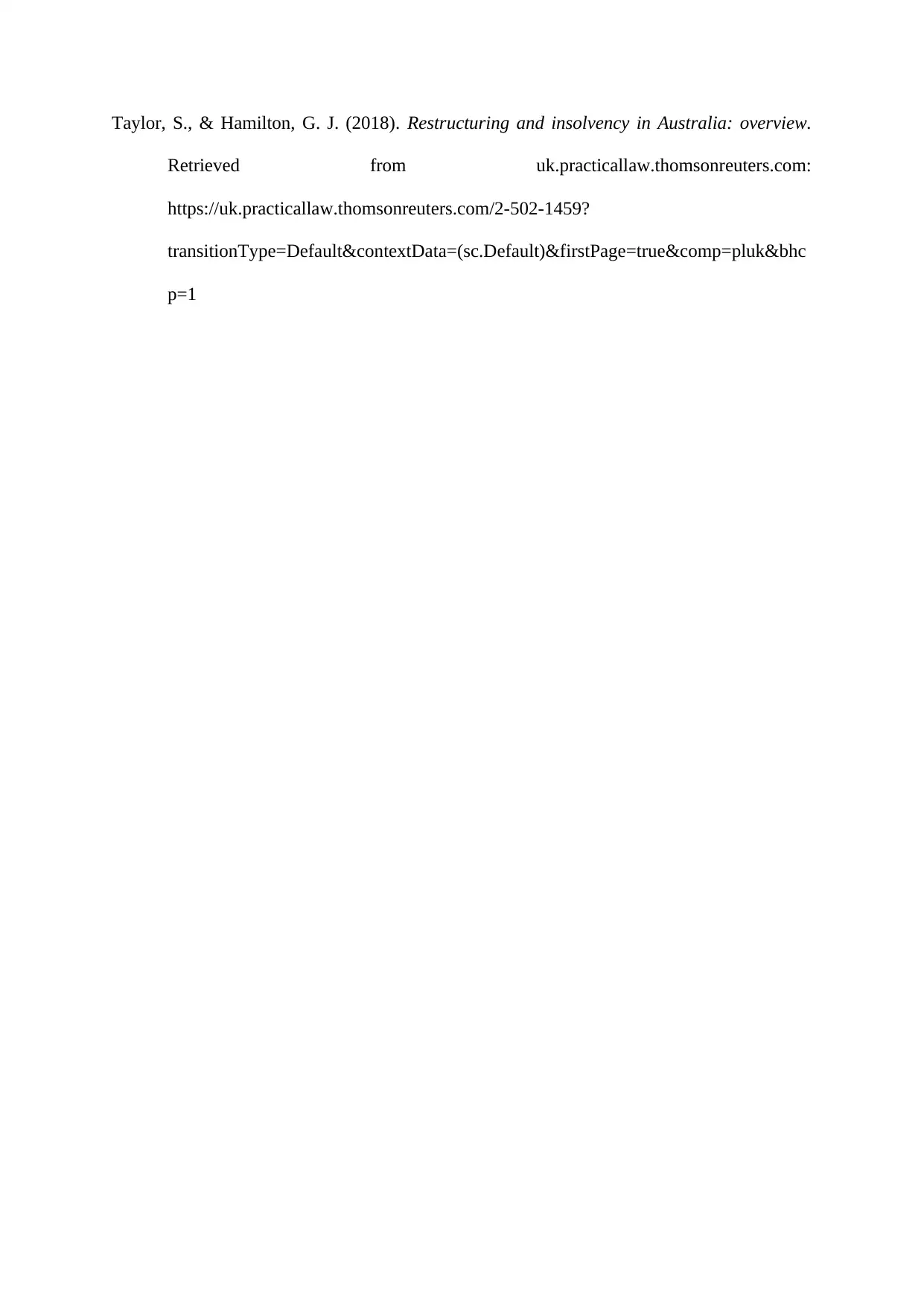
Taylor, S., & Hamilton, G. J. (2018). Restructuring and insolvency in Australia: overview.
Retrieved from uk.practicallaw.thomsonreuters.com:
https://uk.practicallaw.thomsonreuters.com/2-502-1459?
transitionType=Default&contextData=(sc.Default)&firstPage=true&comp=pluk&bhc
p=1
Retrieved from uk.practicallaw.thomsonreuters.com:
https://uk.practicallaw.thomsonreuters.com/2-502-1459?
transitionType=Default&contextData=(sc.Default)&firstPage=true&comp=pluk&bhc
p=1
1 out of 5
Related Documents
Your All-in-One AI-Powered Toolkit for Academic Success.
+13062052269
info@desklib.com
Available 24*7 on WhatsApp / Email
![[object Object]](/_next/static/media/star-bottom.7253800d.svg)
Unlock your academic potential
© 2024 | Zucol Services PVT LTD | All rights reserved.





